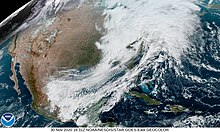|name=. Remove this parameter; the article title is used as the name by default. GOES-16 satellite imagery of the storm complex impacting the Ohio Valley at 16:31 UTC (11:31 a.m. EDT) on November 30 | |
| Meteorological history | |
|---|---|
| Formed | November 29, 2020 |
| Dissipated | December 2, 2020 |
| Winter storm | |
| Highest gusts | 115 km/h (70 mph) |
| Lowest pressure | 993 hPa (mbar); 29.32 inHg |
| Maximum snowfall or ice accretion | 24 in (61 cm) at Thompson, Ohio |
| Tornado outbreak | |
| Tornadoes | 5 |
| Maximum rating | EF1 tornado |
| Duration | 12 hours, 43 minutes |
| Overall effects | |
| Fatalities | None confirmed |
| Damage | >$100 million (2020 USD)[1] |
| Areas affected | Southern United States, Ohio Valley, Northeastern United States, Eastern Canada |
| Power outages | >100,000 |
Part of the 2020–21 North American winter and tornado outbreaks of 2020 | |
The November 2020 North American storm complex was a major early-season snowstorm that impacted most of the Ohio Valley from November 30–December 2 with heavy snow, gusty winds, and near-whiteout conditions. The system originated from a weak gulf low off the coast of Texas on November 29, which began to move northeastward onto land the next day. It then began to strengthen, as well as slowing its movement down, resulting in heavy, wind-driven snow for prolonged periods of time in the Ohio Valley. It also triggered a major lake-effect snow event from December 1–2 as the system stalled over Lake Ontario, resulting in additional heavy snowfall. The storm system was also responsible for a severe thunderstorm outbreak in the Southeast and Mid-Atlantic regions, causing 22 severe thunderstorms and 5 tornadoes. In total, the system is estimated to have caused at least $100 million (2020 USD) in damages.[1] It was unofficially named Winter Storm Dane by The Weather Channel.[2]
- ^ a b "Global Catastrophe Recap – November 2020" (PDF). Aon Benfield. December 10, 2020. p. 4. Retrieved March 6, 2021.
- ^ "Winter Storm Brought Wind-Driven Snow to Eastern Great Lakes, Appalachians". weather.com. December 2, 2020.